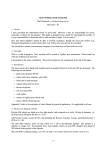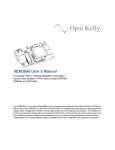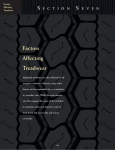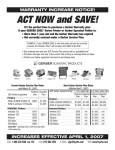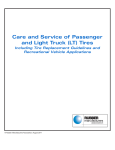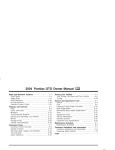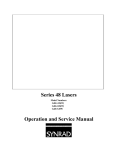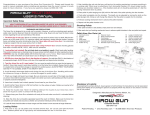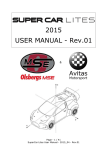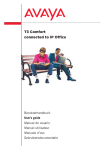Download Owner`s Manual - Michelin Canada
Transcript
Owner’s Manual Passenger and Light Truck Tire Limited Warranty Registration Cards Safety Tips 30-Day Satisfaction Guarantee 3-Year Flat Tire Changing Assistance Limited Mileage Warranty Flat tire changing assistance for three years: MICHELIN® tires are designed with robust construction to resist punctures, but there are still some things that may cause your tire to lose air. We hope you never experience a flat tire with your new MICHELIN® tires, but if you do, the Michelin Promise Plan™ is ready to help. In the event of a flat tire, simply call the toll-free number listed below (also provided on the tear-out wallet card), and a qualified service professional will replace your flat tire with your inflated spare. If an inflated spare is not available, towing will be provided at no cost (up to 250 kilometers) to the nearest approved Michelin retailer of your choice. Flat Tire Assistance is available 24 hours a day, 365 days a year in Canada and the U.S. For flat tire changing assistance call: 1-866-794-5666. Certain conditions and limitations apply. This service does not cover the repair or replacement costs of the tire. The service applies only to motorized passenger and light truck vehicles and specifically excludes trailers, recreational vehicles, commercial vehicles and any vehicle used for farm, ranch, agriculture, racing, or off-road service. This service is not available for original equipment tires. Limited mileage warranty: MICHELIN® passenger and light truck tires – replacement and original equipment – are covered by a limited mileage warranty (hereafter referred to as limited warranty for tread wear). For the mileage warranty associated with each tire line, please see your Michelin tire retailer – or visit us at www.michelinman.ca/promise. Certain conditions and limitations apply. Mileage warranties vary by tire line and certain exclusions may apply. The limited warranty for tread wear is subject to all conditions and limitations, including maintenance recommendations and safety warnings, contained in this Owner’s Manual under the MICHELIN® passenger and light truck tire limited warranty. 2 MICHELIN® PASSENGER AND LIGHT TRUCK TIRE LIMITED WARRANTY ABOUT THE LIMITED WARRANTIES IN THIS OWNER’S MANUAL As the original purchaser of a MICHELIN® passenger or light truck tire, you are covered by all the benefits and conditions (subject to the maintenance recommendations and safety warnings) contained in this Owner’s Manual. To ensure your understanding of and compliance with the terms and conditions of this warranty, please read it carefully. It is essential that you also read and understand the safety and maintenance recommendations for tires contained in this Owner’s Manual. Definitions The warranty coverage of the tire is six years from the date of purchase or the life of the “usable tread,” which is defined as the original tread worn down to the level of the tread wear indicators, which is 2/32nds of an inch (1.6 mm) of tread remaining, whichever occurs first. The date of purchase is documented by a new vehicle registration or tire sales invoice. If no proof of purchase is available, the date of manufacture, as molded on the sidewall, will be used. Uneven wear is defined as a tread groove difference of 2/32nds of an inch or more on the same tire. WHAT IS COVERED AND FOR HOW LONG Workmanship and materials MICHELIN® passenger and light truck tires, used in normal service on the vehicle on which they were originally fitted and in accordance with the maintenance recommendations and safety warnings contained in this Owner’s Manual, are covered by this limited warranty against defects in workmanship and materials for the life of the original usable tread, or six years from date of purchase, whichever comes first. After that time, all warranties, express or implied, expire. Replacement will be made in accordance with the terms and conditions described under “How Replacement Charges are Calculated” on page 5. 3 Tread wear – mileage warranty coverage for MICHELIN® passenger and light truck tires MICHELIN® passenger and light truck tires are covered by a manufacturer’s limited warranty for tread wear. Also please note that mileage warranties apply to tires that come as original equipment on new vehicles purchased on or after September 1, 2011 (model year 2011 and later). For the mileage warranty associated with a specific tire line, please see your Michelin tire retailer or visit us at www.michelinman.ca/promise. Some vehicles come from the vehicle manufacturer with “split fitments” – meaning different size tires on the front and rear axles. Because these tires cannot be rotated as recommended by Michelin, the mileage warranty on each rear tire will cover half the number of kilometers as the standard mileage warranty for that particular tire design. MICHELIN® Self-Supporting Zero Pressure (ZP) tires have the same mileage warranty as the standard tire line of which they are a part, up to but not exceeding 50,000 kilometers. DOT-approved competition tires (e.g., MICHELIN® Pilot® Sport Cup tires) are excluded from any mileage warranty. MICHELIN® winter tires must be used during winter months only, defined as a period beginning on or after September 1 of a given year and ending no later than April 30 of the following year. MICHELIN® winter tires require documentation of the timing of the installation and removal of the tires each winter to maintain coverage under the limited warranty for tread wear. An important reminder: No tire manufacturer can unconditionally guarantee you a certain number of kilometers from a given tire. Driving habits, driving conditions, road conditions, and vehicle maintenance all play a part in the tread life of a tire. If a tire does not reach the warranted mileage, and the owner of the tires has complied with the terms and conditions of the warranty, Michelin will replace the tires as described under “How Replacement Charges are calculated”. WHAT IS NOT COVERED Tires which become unserviceable due to: – Road hazard injury (e.g., a cut, snag, bruise, impact damage or puncture); – Incorrect mounting of the tire, tire/wheel imbalance or improper repair; – Misapplication, improper maintenance, racing, underinflation, overinflation or other abuse; – Uneven or rapid wear which is caused by mechanical irregularity in the vehicle such as wheel misalignment, (a measured tread difference of 2/32nds of an inch or more across the tread on the same tire); – Accident, fire, chemical corrosion, tire alteration or vandalism; – Use in commercial applications for tread wear; – Flat spotting caused by improper storage or brakelock; – The addition of liquid, solid or gaseous materials other than air, nitrogen or carbon dioxide (for example, waterbase sealers or balancing substances); – Cosmetic weather checking; – Use of MICHELIN® Self-Supporting Zero Pressure (ZP) tires without a properly operating low air pressure warning system. Tires branded “Blemished” or “BLEM” are not adjustable for appearance conditions. 4 HOW REPLACEMENT CHARGES ARE CALCULATED Workmanship and materials A tire which becomes unserviceable due to a condition covered by this workmanship and materials limited warranty will be replaced with a comparable new MICHELIN® tire, free of charge, when 2/32nds of an inch (1.6 mm) or less of the original tread is worn, (or 25% or less, whichever is more beneficial to the user) and within 12 months of the date of purchase. Mounting and balancing of the tire is included. You pay the cost of any other service charges and applicable taxes. When more than 2/32nds of an inch of original tread has been worn (or more than 25%, whichever is more beneficial to the user) or after 12 months from date of purchase, you must pay the cost of a comparable new Michelin® passenger or light truck replacement tire on a pro rata basis. The retailer will determine the charge by multiplying the percentage of the original usable tread worn, by the price in the current MICHELIN® Base Price List. You pay the cost of mounting and balancing and any other service charges and applicable taxes or fees. Tread wear A tire meeting the conditions for pro rata replacement, which wears evenly across the tread, down to the tread wear indicators (2/32nds of an inch tread remaining) within six years of the date of purchase, and before delivering the warranted kilometers of service, will be replaced with a comparable new MICHELIN® tire based on mileage received. The participating Michelin tire retailer will determine the charge by multiplying the percent of mileage received by the price of the tire in the current MICHELIN® Base Price List. This list is based on a predetermined price intended to fairly represent the actual selling price of the tire. You pay the cost of mounting, balancing and any other dealer services and applicable taxes or fees. Tires which wear out evenly before delivering the warranted mileage will be replaced on a pro rata basis only if: 1) You are the original purchaser of the tires, you own the vehicle on which they were originally installed, and the tires have been used only on that vehicle; 2) The tires have been rotated and inspected by a participating Michelin tire retailer every 12,000 kilometers, and the attached Mounting and Rotation Service Record has been fully completed and signed; 3) The completed Service Record form, Original Owner/Tire Installation Information form, and the Original Invoice are presented to a participating Michelin tire retailer at the time of adjustment claim; and 4) The tires have not become unserviceable due to a condition listed under WHAT IS NOT COVERED. 5 WHAT THE CONSUMER MUST DO WHEN MAKING A CLAIM When making a claim under the terms of this limited warranty, you must present your tire(s) to a participating Michelin tire retailer. The vehicle on which the tires were used must be available for inspection. For tread wear replacement claims, you must also present your original invoice with your mounting and rotation service record. Personal identification (i.e. Driver’s License, etc.) and vehicle registration may be required. You pay service charges together with applicable taxes and fees for normal vehicle and tire maintenance. When making a 30-day Satisfaction Guarantee claim, you must bring the tires (mounted), and original sales receipt back to the place of purchase within 30 days of purchase. Place of purchase is where you bought the tires and may not necessarily be where you had the tires installed (such as when tires are purchased online). Also see Conditions and Exclusions on this page pertaining to all limited warranties listed in this booklet. CONDITIONS AND EXCLUSIONS These limited warranties do not provide compensation for loss of time, loss of use of vehicle, inconvenience or consequential damage. Some provinces may not allow the exclusion or limitation of incidental or consequential damages, so the above limitation or exclusion may not apply to you. Tires presented for claim remain the property of the consumer and Michelin accepts no responsibility for loss of or damage to tires which are in the custody or control of a Michelin tire retailer for the purpose of inspection for warranty adjustment. Tires accepted for claim become the property of Michelin. In the event of a disputed claim, the consumer must make the tire available for further inspection. No Michelin representative, employee or retailer has the authority to make or imply any representation, promise or agreement, which in any way varies the terms of this warranty. These limited warranties apply only in the United States and Canada. CONSUMER RIGHTS This warranty gives the user specific legal rights, and the user may also have other rights which vary from province to province. SAFETY AND MAINTENANCE RECOMMENDATIONS THE IMPORTANCE OF TIRES The tire is the only contact between your vehicle and the ground. In order to ensure greater safety and to achieve longer tire life, it is essential to adhere to certain principles. Tires are of the utmost importance and the cost of regular maintenance is more than justified. Consequently, we recommend that you read and understand the following information. TIRE DISABLEMENT – SAFETY WARNING Any tire may fail as a result of an improperly repaired puncture, impact damage, improper inflation, overloading or other conditions resulting from use or misuse. Tire failures, such as a rapid air loss or a tread and belt detachment, may increase risk of injury or death and/or property damage. To reduce the risk of a tire failure, Michelin recommends you thoroughly read and follow the recommendations in this Michelin Owner’s Manual, the vehicle owner’s manual, the tire information placard on the vehicle, (located in the vehicle’s door jamb, inside the fuel hatch, or on the glove compartment door), and tire sidewall information regarding safety warnings, proper tire use and maintenance. CONTROLLABILITY Controlling a vehicle when a tire failure occurs If a tire failure occurs, you may hear a loud noise, feel a vibration, and/ or the vehicle may pull toward the side of the failed tire. If possible, step on the accelerator momentarily to maintain forward momentum and ensure vehicle control. It is most important that you DO NOT BRAKE OR ABRUPTLY TURN THE STEERING WHEEL. Slowly remove your foot from the accelerator and hold the steering wheel firmly while steering to remain in your lane. Once the vehicle has slowed and is fully under control, gently apply the brakes, safely pull over to the shoulder and come to a stop. Inspect the tires. If one or more looks flat or low, shows detachment or other damage, remove tire assembly and replace it with a properly inflated spare. Bumps or bulges may indicate detachment within the tire body and require inspection by a qualified tire technician. SAFETY MAINTENANCE INFORMATION Read this Owner’s Manual, the information on the sidewall of your tires, your vehicle owner’s manual and the tire information placard that came on your vehicle, for essential safety and maintenance information. You should have complete confidence in your new MICHELIN® tires. Still, it’s important to register your tires in the event that we need to contact you. For online tire registration, visit www.michelinman.ca. For assistance in locating a participating Michelin tire retailer for service, please call 1-888-871-4444, or visit www.michelinman.ca. 6 7 DRIVING ON ANY TIRE THAT DOES NOT HAVE THE CORRECT INFLATION PRESSURE IS DANGEROUS MICHELIN® SELF-SUPPORTING ZERO PRESSURE (ZP) TIRES AT LOW OR ZERO AIR PRESSURE Any underinflated tire builds up excessive heat that may result in sudden tire destruction. If tires are supplied as original equipment, refer to the tire information placard that came on your vehicle, (located in the vehicle’s door jamb, inside the fuel hatch or on the glove compartment door), for the recommended operating pressures. For replacement tires, the correct inflation pressure will be provided by your tire retailer; if not, refer to the vehicle decal. These inflation pressures must be maintained as a minimum. However, do not exceed the maximum pressure rating indicated on the tire sidewall. The handling characteristics of a vehicle with a deflated Self-Supporting Zero Pressure (ZP) tire (whether front or rear) are not the same as those of a vehicle with normally inflated tires. Avoid high speeds and hard cornering whenever a low pressure warning is activated. Even a MICHELIN® Self-Supporting Zero Pressure (ZP) tire can build up excessive heat when run underinflated for an extended period of time. The length of time and distance a Self-Supporting Zero Pressure (ZP) tire will perform at low or zero air pressure will depend upon the severity of the event causing air loss, ambient temperature, speed at which the tire is operated, and the conditions under which the tire is operated (e.g. hard braking, cornering and other sharp manœuvers will greatly reduce the length of time the tire can perform at low or zero air pressure.) Continuous use of an underinflated tire may lead to sudden tire destruction. If a tire at low or zero pressure begins to vibrate or cause difficulty in vehicle handling, remove the tire immediately and replace with the temporary spare. If MICHELIN® Self-Supporting Zero Pressure (ZP) tires are supplied as original equipment, refer to the vehicle owner’s manual for complete details on the low tire pressure warning system designed to alert you in the event of a low pressure condition. CHECK THE COLD INFLATION PRESSURE IN ALL YOUR TIRES, INCLUDING THE SPARE, AT LEAST ONCE EACH MONTH Failure to maintain correct inflation may result in improper vehicle handling and may cause rapid and irregular tire wear, sudden tire destruction, loss of vehicle control, and serious personal injury. Therefore, inflation pressures should be checked at least once each month and always before long distance trips. This applies to all tires, including sealant types, and selfsupporting tires, which are as susceptible to losing air pressure as any other type of tire if not properly maintained. Pressures should be checked when tires are cold; in other words, before they have been driven on. Driving, even for a short distance, causes tires to heat up and air pressure to increase. UNDERINFLATION It is impossible to determine whether tires are properly inflated by simply looking at them. It is almost impossible to “feel” or “hear” when a tire is being run underinflated or nearly flat. Tires must be checked monthly with a tire pressure gauge. CHECKING PRESSURE WHEN TIRES ARE HOT If pressures are checked after tires have been driven for more than three minutes or more than 2 km, the tires become hot and the pressures will increase by approximately 4 psi (30 kPa). Therefore, when tire pressure is adjusted under these conditions, it should be increased to a gauge reading of 4 psi (30 kPa) greater than the recommended cold inflation pressure. NOTE: MICHELIN® SELF-SUPPORTING ZERO PRESSURE (ZP) TIRES ARE TO BE USED ONLY IN CONJUNCTION WITH AN OPERATIONAL, MICHELIN® APPROVED, LOW TIRE PRESSURE WARNING SYSTEM. Otherwise, all provisions of the limited warranty are void. For a list of approved systems, see your participating Michelin tire retailer, or call 1-888-871-4444. NOTE: Some MICHELIN® Self-Supporting Zero Pressure (ZP) tires can only be mounted on special SH-M (Symmetric Hump - Modified) wheels. These tires bear the special SH-M designation, molded into the sidewall of the tire, next to the ZP designation. DO NOT MOUNT A TIRE WITH THE SH-M DESIGNATION ON THE SIDEWALL ON A STANDARD WHEEL. DOING SO VOIDS THIS LIMITED WARRANTY AND COULD CAUSE THE TIRE TO BECOME UNSERVICEABLE AT LOW OR ZERO PRESSURE, RESULTING IN SERIOUS PERSONAL INJURY OR DEATH. For all types of tires, consult your vehicle owner’s manual or the tire information placard that came on your vehicle for recommended operating pressures. If the tires are purchased as replacement tires, operating instructions for the low pressure warning system will be provided by the manufacturer of that system. Recommended operating pressures will be provided by a participating Michelin tire retailer for self supporting ZP tires. These inflation pressures must be maintained as a minimum. However, do not exceed the maximum pressure rating indicated on the tire sidewall. For example only: Gauge reading of hot tire: 32 psi (220 kPa) If recommended cold inflation is: 30 psi (205 kPa) Desired gauge reading of hot tire is: 30 + 4 = 34 psi (205 + 30 = 235 kPa) Therefore add: 2 psi (15 kPa) Check cold pressure as soon as possible, preferably within 24 hours. “Bleeding” air from hot tires could result in underinflation. Use an accurate tire gauge to check pressures. Never allow children to inflate or deflate tires. 8 9 FOR MICHELIN® SELF-SUPPORTING ZERO PRESSURE (ZP) TIRES CHECK INFLATION PRESSURES AS SOON AS POSSIBLE FOLLOWING A LOW PRESSURE WARNING MICHELIN® Self-Supporting Zero Pressure (ZP) tires require a functioning, correctly calibrated, onboard vehicle tire pressure monitoring system (TPMS) to monitor the air pressure and alert the driver when a low pressure event occurs. Be certain to ensure that your vehicle’s Tire Pressure Monitoring System (TPMS) is functioning and is correctly calibrated. Refer to your vehicle owner’s manual or your vehicle dealer. Low pressure warning systems are designed to alert the driver to a low air pressure situation in at least one tire on the vehicle. While your ZP tires are designed to provide continued mobility in the event of an air loss, the sooner you respond to a warning and take corrective action, the greater the likelihood that the tire can be returned to service. Always visually inspect your MICHELIN® Self-Supporting tires and use a pressure gauge to check the air pressure in all four tires following any low pressure warning (unless advised to do otherwise by the manufacturer of your low pressure warning system) If the tire pressure is at or below 18 PSI, proceed to the nearest participating Michelin tire retailer for ZP tires (or a representative of your vehicle manufacturer if advised to do so in your vehicle owner’s manual) and have the tire demounted and thoroughly inspected for possible internal damage. If you are unable to see any damage to the tire, and the tire pressure is more than 18 PSI, reinflate your tire to the proper air pressure. (See instructions for checking pressures when tires are hot on page 8.) When tires have cooled, check air pressure again. If any tire has lost more than 5 PSI from the previous pressure check, have the tire inspected at once by a participating Michelin tire retailer (or representative of your vehicle manufacturer if your vehicle owner’s manual so advises.) Failure to do so may cause irreparable damage to the tire and result in sudden tire destruction and personal injury. TIRE PRESSURE MONITORING SYSTEMS (TPMS) Your vehicle may be equipped with a Tire Pressure Monitoring System (TPMS) that is designed to monitor the pressure of tires mounted on your vehicle and sends a signal to the driver if a tire pressure falls below a predetermined level. A TPMS should not replace monthly manual pressure checks for all four tires and the spare. We recommend that you manually monitor and check tire pressure inflation with a pressure gauge. Your tires should have the recommended pressure listed by your vehicle’s manufacturer. This information can be found in the vehicle owner’s manual and often on a placard located in the vehicle’s door jamb, inside the fuel hatch, or on the glove compartment door. If you have a plus-size fitment that requires a higher inflation pressure, your tire pressure monitoring system will require re-calibration to new inflation pressure. Refer to your tire dealer/installer of plus-size tires for proper inflation pressure. We recommend checking air pressure once each month, and before a long trip. Whether you have a full-sized or mini-spare, make sure that it is properly inflated as well. If the TPMS generates improper monitoring or signals, we recommend that you consult your vehicle owner’s manual and follow up with your vehicle’s manufacturer. TIRE SPINNING Do not spin wheels in excess of 55 km/h as indicated on the speedometer. Excessive speed in a free-running, unloaded tire can cause it to “explode” from centrifugal force. The energy released by such an explosion is sufficient to cause serious physical injury or death. Never allow anyone to stand near or behind the spinning tire. When in mud, sand, snow, ice or other slippery conditions, do not engage in excessive wheel spin. Accelerating the motor excessively, particularly with automatic transmission vehicles, may cause a drive tire that has lost traction to spin beyond its speed capability. This is also true when balancing a drive tire/wheel assembly on the vehicle using the vehicle engine to spin the tire/wheel assembly. HIGH SPEED DRIVING CAN BE DANGEROUS Correct inflation pressure is especially important. However, at high speeds, even with the correct inflation pressure, a road hazard is more difficult to avoid and if contact is made, has a greater chance of causing tire damage than at a lower speed. Moreover, driving at high speed reduces the reaction time available to avoid accidents and bring your vehicle to a safe stop. If you see any damage to a tire or wheel, replace it with the spare at once and visit a participating Michelin Tire Retailer. Exceeding the maximum speeds shown on the following page for each type of MICHELIN® tire will cause the tire to build up excessive heat, which can cause tire damage that could result in sudden tire destruction and rapid air loss. Failure to control a vehicle when one or more tires experience a sudden air loss can lead to an accident. In any case, you should not exceed reasonable speeds as indicated by the legal limits and driving conditions. 10 11 SPEED RATING SYSTEM “Z” Rated Tires The speed rating of a tire indicates the speed category (or range of speeds) at which the tire can carry a load under specified service conditions. The speed rating system used today was developed in Europe in response to the need to categorize Speed Speed Speed tires into standardized Symbol (km/h) (mph) speeds. A letter from A to Z symbolizes a tire’s L 120 75 certified speed rating, M 130 81 ranging from 5 km/h to above 300 km/h. This N 140 87 rating system (see chart P 150 94 on this page) describes the top speed for which Q 160 100 a tire is certified. R 170 106 When this speed rating S 180 112 system was originally developed, the Unlimited T 190 118 V category of over 210 U 200 124 km/h was the top speed rating a tire could achieve. H 210 130 As manufacturers made V 240 149 more tires that fit into this category, it was W 270 168 necessary to better Y 300 186 regulate performance at ZR standardized speeds to Above 186 (Y) Above 300 (consult tire manufacter) help ensure safety. The Limited V category of 240 km/h was then created, and the Z or (Y) speed rating was added as the top speed rating that a tire could achieve. W and Y limited speed symbols have been added as higher speed categories. When “Z” appears in the size description with the service description, the maximum speed is indicated by the service description. Examples: Always consut the tire manufacturer for the maximum speed of Unlimited Z or (Y) tires. Speed rating is identified as a part of the tire’s sizing or service description. Exceeding the lawful speed limit is neither recommended nor endorsed. In the latest attempt to standardize tire designations, all ratings except Unlimited Z incorporate the speed symbol and load index as the tire’s service description. For example: 205/60R15 91V 205 60 R 15 91V = = = = = Section Width in Millimeters Aspect Ratio Radial Construction Rim Diameter in Inches Service Description (Load Index and Speed Rating) 12 Tire Designation Maximum Speed P275/40ZR17 P275/40R17 93Y P275/40ZR17 93Y P275/40ZR17 (93Y) Above 240 km/h* 300 km/h 300 km/h Above 300 km/h* *Consult Tire Manufacturer For tires having a maximum speed capability above 240 km/h, a “Z” may appear in the size designation. For tires having a maximum speed capability above 300 km/h, a “Z” must appear in the size designation and the service description must include Y in parenthesis. Example: 275/40ZR18 (99Y). Consult the tire manufacturer for maximum speed when there is no service description. Consult your Michelin tire retailer for maximum speed capabilities. Although a tire may be speed-rated, we do not endorse the operation of any vehicle in an unsafe or unlawful manner. Speed ratings are based on laboratory tests which relate to performance on the road, but are not applicable if tires are underinflated, overloaded, worn out, damaged, altered, improperly repaired or retreaded. Furthermore, a tire’s speed rating does not imply that vehicles can be safely driven at the maximum speed for which the tire is rated, particularly under adverse road and weather conditions or if the vehicle has unusual characteristics. MICHELIN® highway passenger tires that do not have a speed symbol on the sidewall have a maximum speed rating of 170 km/h. Light truck highway tires that do not have a speed symbol on the sidewall of the tire have a maximum speed rating of 140 km/h. MICHELIN® winter tires that do not have a speed symbol on the sidewall or tires with Q symbols have a speed rating of 160 km/h. Winter tires with a speed symbol have a maximum speed rating in accordance with the symbol. The speed and other ratings of retreaded tires are assigned by the retreader and replace the original manufacturer’s ratings. IMPORTANT: In order to maintain the speed capability of the vehicle, replacement tires must have speed ratings equal to or higher than those fitted as original equipment (as indicated on the tire information placard that came on your vehicle or in the vehicle owner’s manual). If tires with lower speed ratings are fitted, the vehicle’s handling may be affected and the speed capability of the vehicle will be lowered to the maximum speed capability of the replacement tires as indicated in the above table. REMEMBER…High speed driving can be dangerous and may damage your tires. AND…When driving at highway speeds, correct inflation pressure is especially important. 13 INSPECT YOUR TIRES – DO NOT DRIVE ON A DAMAGED TIRE OR WHEEL HAZARDS Objects in the road, such as potholes, glass, metal, rocks, wood, debris and the like, can damage a tire and should be safely avoided. Unavoidable contact with such objects should prompt a thorough tire inspection. Anytime you see any damage to your tires or wheels, replace with the spare at once and immediately visit any Michelin tire retailer. IMPACT DAMAGE A tire impacted by a road hazard (curb, pothole, debris) may be damaged but not have visible signs of damage on its surface. A tire damaged by an impact may sustain a sudden failure a day, week, or even months later. You may not recall hitting an object that damaged or injured your tires. Air loss, unusual tirewear, localized wear or vibrations can also be signs of internal tire damage. If you suspect any damage to your tire or wheel from an impact with a curb, pothole, debris on the road or any other road hazard, or if you feel or hear any unusual vibration, replace with a properly inflated spare at once and immediately visit any qualified tire technician. INSPECTION When inspecting your tires, including the spare, check the air pressures. If the pressure check indicates that one of your tires has lost pressure of two pounds or more, look for signs of penetration, valve leakage or wheel damage that may account for the air loss. Always look for bulges, cracks, cuts, penetrations, and abnormal tire wear, particularly on the edges of the tire tread, which may be caused by misalignment or underinflation. If any such damage is found, the tire must be inspected by any participating Michelin tire retailer at once. Use of a damaged tire could result in tire destruction. All tires will wear out faster when subjected to high speeds, as well as hard cornering, rapid starts, sudden stops, frequent driving on roads which are in poor condition, and off-road use. Roads with holes and rocks or other objects can damage tires and cause misalignment of your vehicle. When driving on such roads, drive carefully and slowly, and before driving again at normal or highway speeds, examine your tires for any damage, such as cuts, bulges, penetrations, unusual wear patterns, etc. 14 WEAR BARS MICHELIN® tires contain “Wear Bars” in the grooves of the tire tread which become visible when only 2/32nds of an inch (1.6 mm) of tread is remaining. At this stage, your tires must be replaced. Tires worn beyond this stage are extremely dangerous. DO NOT OVERLOAD – DRIVING ON ANY OVERLOADED TIRE IS DANGEROUS The maximum load rating of your tires is molded on the tire sidewall. Do not exceed this rating. Follow the loading instructions of the manufacturer of your vehicle and this will ensure that your tires are not overloaded. Tires which are loaded beyond their maximum allowable loads for the particular application will build up excessive heat that may result in sudden tire destruction. Do not exceed the gross axle weight rating for any axle on your vehicle. TRAILER TOWING If you anticipate towing a trailer, you should visit any Michelin tire retailer for advice concerning the correct size tire and pressures. Tire size and pressures will depend upon the type and size of trailer and hitch utilized, but in no case must the maximum cold inflation pressure or tire load rating be exceeded. Check the tire information placard that came on your vehicle, located in the vehicle’s door jamb, inside the fuel hatch, or on the glove compartment door, and the owner’s manual supplied by the manufacturer of your vehicle for further recommendations on trailer towing. MICHELIN® Self-Supporting Zero Pressure (ZP) tires and trailer towing Operation of ZP tires at low or zero air pressure with a trailer in tow is dangerous and is not recommended. If the low pressure warning indicator is activated when a trailer is in tow, stop, disconnect the trailer, and do not continue to tow the trailer until the tire has been repaired and re-inflated to the proper air pressure. If the tire cannot be repaired, it must be replaced with a new full-size, matching ZP tire, and inflated to the proper air pressure before the trailer can be safely towed again. 15 WHEEL ALIGNMENT AND BALANCING ARE IMPORTANT FOR SAFETY AND MAXIMUM MILEAGE FROM YOUR TIRES. CHECK HOW YOUR TIRES ARE WEARING AT LEAST ONCE EACH MONTH If your tires are wearing unevenly, such as the inside shoulder of the tire wearing faster than the rest of the tread, or if you detect excessive vibration, your vehicle may be out of alignment or balance. These conditions not only shorten the life of your tires but adversely affect the handling characteristics of your vehicle, which could be dangerous. If you detect irregular wear or vibration, have your alignment and balance checked immediately. Tires which have been run underinflated will show more wear on the shoulders than in the center of the tread. TIRE MIXING MICHELIN® tires are radial tires and for best performance it is recommended that the same size and type of tire be used on all four wheel positions. Before mixing tires of different types in any configuration on any vehicle, be sure to check the vehicle manufacturer’s owner‘s manual for its recommendations. It is especially important to check the vehicle manufacturer’s owner’s manual when mixing, matching, or replacing tires on 4-wheel drive vehicles, as this may require special precautions. MICHELIN DOES NOT RECOMMEND MIXING SELF-SUPPORTING ZERO PRESSURE (ZP) TIRES WITH NON-ZP TIRES OTHER THAN THE TEMPORARY USE OF THE SPARE IF THE VEHICLE IS SO EQUIPPED. ® WINTER DRIVING Tires which meet the Rubber Manufacturers Association (RMA) definition of snow tires are marked M/S, M+S, or M&S. On such tires, this designation is molded into the sidewall. Tires without this notation are not recommended for winter driving. While all-season tires are designed to provide reliable performance in moderate winter conditions, the use of four winter tires is recommended for optimal performance and may be mandatory in certain jurisdictions. Tires designated for use in severe winter conditions are marked on at least one sidewall with the letter “M” and “S” plus a pictograph of a mountain with a snowflake on it. 16 TIRE ROTATION AND REPLACEMENT To obtain maximum tire wear, it may be necessary to rotate your tires. Refer to your vehicle owner’s manual for instructions on tire rotation. If you do not have an owner‘s manual for your vehicle, Michelin recommends rotating your tires every 10,000 to 12,000 km. Monthly inspection for tire wear is recommended. Your tires should be rotated at the first sign of irregular wear, even if it occurs before 10,000 km. This is true for all vehicles. When rotating tires with a directional tread pattern, observe the arrows molded on the sidewall which show the direction the tire should turn. Care must be taken to maintain the proper turning direction. Some Tire Pressure Monitoring Systems (TPMS) may not recognize that a tire has been moved to a different position on your vehicle. Make certain that your TPMS system is reset, if necessary, so as to correctly identify the location of each tire on your vehicle. Refer to your vehicle owner’s manual or your vehicle dealer. Determine whether rotated tires require tire inflation adjustment, as front and rear position tire pressure may vary according to the vehicle manufacturer’s specification due to the actual load on that wheel position. Some vehicles may have different-sized tires mounted on the front and rear axles, and these different-sized tires have rotation restrictions. Always check the vehicle owner’s manual for the proper rotation recommendations. Full-size spare Full-size spare tires (not temporary spares) of the same size and construction should be used in a five tire rotation. Always check the inflation pressure of the full-size spare immediately before incorporating it into rotation. Follow the vehicle manufacturer’s recommended pattern for rotation, or if not available, see a qualified tire technician. Replacement of two tires It is recommended that all four tires be replaced at the same time. However, when only two tires are replaced, the new ones should be put on the rear. The new tires, with deeper tread, may provide better grip and water evacuation in wet driving conditions. CUSTOMIZATION OF TIRES, WHEELS, OR SUSPENSION ON SUVs AND LIGHT TRUCKS Due to their size, weight and higher centre of gravity, vehicles such as SUVs and light trucks do not have the same handling characteristics as automobiles. Because of these different characteristics, failure to operate your SUV/truck in a proper and safe manner can increase the likelihood of vehicle rollover. Modifications to your SUV/truck tire size, tire type, wheels or suspension can change its handling characteristics and further increase the likelihood of vehicle rollover. Whether your SUV/truck has the original equipment configuration for tires, wheels and suspension or whether any of these items have been modified, always drive safely, avoid sudden, sharp turns or lane changes and obey all traffic laws. Failure to do so may result in loss of vehicle control leading to an accident and serious injury or death. 17 TIRE ALTERATIONS FOLLOW THESE MOUNTING RECOMMENDATIONS Do not make or allow to be made any alterations on your tires. Alterations may prevent proper performance, leading to tire damage which can result in an accident. Tires which become unserviceable due to alterations such as truing, whitewall inlays, addition of balancing or sealant liquids, or the use of tire dressing containing petroleum distillates are excluded from warranty coverage. Tire mounting can be dangerous and must be done by professionally trained persons using proper tools and procedures as specified by the Rubber Manufacturers Association (RMA). REPAIRS – WHEREVER POSSIBLE, SEE YOUR MICHELIN TIRE RETAILER AT ONCE If any MICHELIN® tire sustains a puncture, have the tire demounted and thoroughly inspected by any participating Michelin tire retailer for possible damage that may have occurred. A tread area puncture in any MICHELIN® passenger or light truck tire can be repaired provided that the puncture hole is not more than 1/4” in diameter, and the tire has not been damaged further by the puncturing object or by running underinflated. Tire punctures consistent with these guidelines can be repaired by following the Rubber Manufacturers Association (RMA) recommended repair procedures. TIRE REPAIRS Repairs of all tires must be of the combined plug and inside patch type. Your MICHELIN® tires (including MICHELIN® ZP tires) must be removed from the wheel for inspection prior to repair. Plug-type repairs made on a tire that remains mounted on a wheel are improper. A tire should be removed from the rim and inspected prior to repair. Any tire repair done without removing the tire from the rim is improper. An improperly repaired tire may cause further damage to the tire by either leaking air or allowing air, moisture and contaminants to enter the structure of the tire. An improperly repaired tire can fail suddenly at a later date. Never repair a tire with less than 2/32nds of an inch tread remaining. At this tread depth, the tire is worn out and must be replaced. STORAGE Tires contain waxes and emollients to protect their outer surfaces from ozone and weather checking. As the tire rolls and flexes, the waxes and emollients continually migrate to the surface, replenishing this protection throughout the normal use of the tire. Consequently, when tires sit outdoors, unused for long periods of time (a month or more) their surfaces become dry and more susceptible to ozone and weather checking and the casing becomes susceptible to flat spotting. For this reason, tires should always be stored in a cool, dry, clean, indoor environment. If storage is for one month or more, eliminate the weight from the tires by raising the vehicle or by removing the tires from the vehicle. Failure to store tires in accordance with these instructions could result in damage to your tires or premature aging of the tires and sudden tire failure. When tires are stored, be sure they are placed away from sources of heat and ozone such as hot pipes and electric generators. Be sure that surfaces on which tires are stored are clean and free from grease, gasoline or other substances which could deteriorate the rubber. (Tires exposed to these materials during storage or driving could be subject to sudden failure.) 18 Your tires should be mounted on wheels of correct size and type and which are in good, clean condition. Wheels that are bent, chipped, rusted (steel wheels) or corroded (alloy wheels) may cause tire damage. The inside of the tire must be free from foreign material. Have your tire retailer check the wheels before mounting new tires. Mismatched tires and rims can explode during mounting. Also, mismatched tires and rims can result in dangerous tire failure on the road. If a tire is mounted by error on the wrong-sized rim, do not remount it on the proper rim – scrap it. It may have been damaged internally (which is not externally visible) by having been dangerously stretched and could fail on the highway . Old valves may leak. When new tubeless tires are mounted, have new valves of the correct type installed. Tubeless tires must only be mounted on wheels designed for tubeless tires i.e., wheels which have safety humps or ledges. Always utilize valve caps capable of containing the tire’s air pressure, should the valve core leak. The valve cap is the primary seal against air loss. Each tire and wheel assembly should be balanced to insure proper tire and vehicle performance and to maintain tire warranty coverage. Tires and wheel assemblies which are not balanced may cause steering difficulties, a bumpy ride, and irregular tire wear. SPECIAL MOUNTING INSTRUCTIONS FOR SELF-SUPPORTING ZERO PRESSURE (ZP) TIRES ZP tires can be more difficult to mount than conventional tires. They should be mounted and demounted only by a properly trained tire professional. ZP tires can generate a tremendous amount of heat when run at low or zero pressure. ALWAYS ALLOW A ZP TIRE TO COOL BEFORE ATTEMPTING TO HANDLE IT. FAILURE TO DO SO COULD RESULT IN INJURY. MICHELIN® ZP tires are tubeless tires designed to operate in emergency conditions at low or zero air pressure. MICHELIN® SELF-SUPPORTING ZERO PRESSURE (ZP) TIRES AND SPECIAL SH-M (SYMMETRIC HUMP-MODIFIED) WHEELS Some MICHELIN® ZP tires can only perform with zero pressure capability when mounted on special SH-M wheels. These tires bear the SH-M designation immediately following the ZP designation on the sidewall of the tire. DO NOT MOUNT ZP TIRES WITH THE SH-M DESIGNATION ON STANDARD WHEELS. IN SUCH APPLICATIONS, THE TIRES MAY BECOME UNSERVICEABLE AT LOW OR ZERO PRESSURE, CAUSING SERIOUS PERSONAL INJURY OR DEATH. 19 TEMPORARY TYPE SPARE TIRES When using any temporary-type spare tire, be sure to follow the vehicle manufacturer’s instructions. READING THE DOT DOT XXXX XXXX XXX (prior to August 2000) DOT XXXX XXXX XXX t (1990-1999) DOT XXXX XXXX XXXX (after July 2000) THE DOT The “DOT” symbol certifies the tire manufacturer’s compliance with Transport Canada and U.S. Department of Transportation tire safety standards. Next to the symbol is the tire identification or “serial number”. The first two characters identify the plant where the tire was manufactured. The next two characters reflect the tire size. The following one to four digits may be used at the tire manufacturer’s option as a descriptive code. The last three characters are numbers identifying the week and year of manufacture. (Example: “O25” means second week of the year of decade, eg.: 1995, 1985, etc.) For the 1990-1999 decade MICHELIN® brand tires are marked with a triangle pointing to the last three numeric characters. Tires produced after July 2000 have an additional digit to identify a given decade. For example, 2800 means the tire was produced during the 28th week of 2000; 0201 during the 2nd week of 2001. If the last digits of your DOT number contains three numeric characters and is not marked with a triangle, consult a qualified tire technician to determine the year of manufacture. SERVICE LIFE FOR PASSENGER CAR AND LIGHT TRUCK TIRES, INCLUDING SPARE TIRES The following recommendation applies to passenger car and light truck tires. Tires are composed of various types of material and rubber compounds, having performance properties essential to the proper functioning of the tire itself. These component properties evolve over time. For each tire, this evolution depends upon many factors such as weather, storage conditions, and conditions of use (load, speed, inflation pressure, maintenance etc.) to which the tire is subjected throughout its life. This service-related evolution varies widely, so that accurately predicting the serviceable life of any specific tire in advance is not possible. That is why, in addition to regular inspections and inflation pressure maintenance by consumers, it is recommended to have passenger car and light truck tires, including spare tires, inspected regularly by a qualified tire specialist, such as a Michelin tire retailer, who will assess the tire’s suitability for continued service. Tires which have been in use for five years or more should continue to be inspected by a specialist at least annually. Consumers are strongly encouraged to be aware not only of their tires’ visual condition and inflation pressure, but also of any change in dynamic performance such as increased air loss, noise or vibration, which could be an indication that the tires need to be removed from service to prevent tire failure. It is impossible to predict when tires should be replaced based on their calendar age alone. However the older a tire, the greater the chance that it will need to be replaced due to the service-related evolution or other conditions found upon inspection or detected during use. While most tires will need replacement before they achieve 10 years, it is recommended that any tires in service 10 years or more from the date of manufacture, including spare tires, be replaced with new tires as a simple precaution even if such tires appear serviceable and even if they have not reached the legal wear limit. For tires that were on an original equipment vehicle (i.e., acquired by the consumer on a new vehicle), follow the vehicle manufacturer’s tire replacement recommendations when specified (but do not exceed 10 years). The date when a tire was manufactured is located on the sidewall of each tire. Consumers should locate the Department of Transportation or DOT code on the tire which begins with DOT and ends with the week and year of manufacture. For example, a DOT code ending with “2204” indicates a tire made in the 22nd week (May) of 2004. REMEMBER... TO AVOID DAMAGE TO YOUR TIRES AND POSSIBLE ACCIDENT: • CHECK TIRE PRESSURE AT LEAST ONCE EACH MONTH WHEN TIRES ARE COLD AND BEFORE LONG TRIPS. • DO NOT UNDERINFLATE/OVERINFLATE. • DO NOT OVERLOAD. • DRIVE AT MODERATE SPEEDS, OBSERVE LEGAL LIMITS. • AVOID DRIVING OVER POTHOLES, OBSTACLES, CURBS OR EDGES OF PAVEMENT. • AVOID EXCESSIVE WHEEL SPINNING. • IF YOU SEE ANY DAMAGE TO A TIRE, REPLACE WITH THE SPARE AND VISIT ANY MICHELIN TIRE RETAILER AT ONCE. • IF YOU HAVE ANY QUESTIONS. CONTACT YOUR MICHELIN TIRE RETAILER. 20 21 If you see any damage to your tires or wheels, contact your local participating Michelin tire retailer listed in the Yellow Pages, or visit our web site listed below for dealer locations. If further assistance is required, contact: IN CANADA 1-888-871-4444 or write: Michelin North America (Canada) Inc. 2500 Daniel-Johnson Blvd., Suite 500 Laval, Quebec H7T 2P6 or visit: www.michelinman.ca For Flat Tire Changing Assistance call: 1-866-794-5666 IN THE USA 1-800-847-3435 or write: Michelin North America, Inc. Attention: Consumer Care Department Post Office Box 19001 Greenville, SC 29602-9001 or visit: www.michelinman.com 22 ODOMETER READING RETAILER’S NAME AND ADDRESS RETAILER SIGNATURE PSI (check) To validate the mileage portion of this warranty, your tires must be inspected and rotated every 12,000 kilometers and the PSI set as recommended on the vehicle tire information placard. Winter tires require documentation of the timing of the installation and removal of the tires each winter season to maintain coverage. Owner Certification: I hereby certify these services were performed as indicated and that I am the original purchaser of the tires and the owner of the vehicle on which they were originally installed and exclusively used. Consumer Signature_____________________________________________ Date ________________ DATE OF ROTATION SEASONAL CHANGE Installed Mileage:_____________________________________________ MOUNTING AND ROTATION SERVICE RECORD (FOR LIMITED MILEAGE WARRANTIES ONLY) FAILURE TO OBSERVE ANY OF THE RECOMMENDED PRECAUTIONS CONTAINED IN THIS OWNER’S MANUAL CAN LEAD TO ERRATIC VEHICLE BEHAVIOR AND/OR TIRE DAMAGE, POSSIBLY RESULTING IN AN ACCIDENT. 23 24 ODOMETER READING RETAILER’S NAME AND ADDRESS RETAILER SIGNATURE PSI (check) To validate the mileage portion of this warranty, your tires must be inspected and rotated every 12,000 kilometers and the PSI set as recommended on the vehicle tire information placard. Winter tires require documentation of the timing of the installation and removal of the tires each winter season to maintain coverage. Owner Certification: I hereby certify these services were performed as indicated and that I am the original purchaser of the tires and the owner of the vehicle on which they were originally installed and exclusively used. Consumer Signature_____________________________________________ Date ________________ DATE OF ROTATION SEASONAL CHANGE Installed Mileage:_____________________________________________ MOUNTING AND ROTATION SERVICE RECORD (FOR LIMITED MILEAGE WARRANTIES ONLY) NOTES: 25 here INDEX Alteration.......................................................................................1 8 Contact Us......................................................................................2 2 Controllability.................................................................................. 7 West Caldwell, NJ 07007-2506 MICHELIN NORTH AMERICA (CANADA) INC. MNA, INC. TIRE REGISTRY 2500 Daniel-Johnson Boulevard, Suite 500 Post Office 2506 MNA, INC. TIREBox REGISTRY Laval, QuebecWest H7T Caldwell, 2P6 07007-2506 Post OfficeNJ Box 2506 Affix postcard Affix stamp postcard here stamp NOTES: Customization................................................................................1 7 DOT................................................................................................2 0 High Speed Driving.........................................................................1 1 Inflation.....................................................................................8 - 11 Michelin Promise PlanTM................................................................1 - 2 Mounting.......................................................................................1 9 Overload.........................................................................................1 5 Repairs............................................................................................1 8 Rotation..........................................................................................1 7 Service Life......................................................................................2 1 Speed Ratings..........................................................................12 - 13 Spinning.........................................................................................1 1 Storage...........................................................................................1 8 Temporary Spares............................................................................2 0 Tire Disablement...............................................................................7 Tire & Wheel Inspection..................................................................1 4 Tire Mixing.....................................................................................1 6 Trailer Towing.................................................................................1 5 Warranty......................................................................................... 3 Wear Bars.......................................................................................1 5 Wheel Alignment............................................................................1 6 Wheel Balance................................................................................1 6 Winter Driving................................................................................1 6 This service provides coverage for three years from the date of purchase. This service does not cover the repair or replacement costs of the tire. The service applies only to motorized passenger and light truck vehicles and specifically excludes trailers, recreational vehicles, commercial vehicles and any vehicle used for farm, ranch, agriculture, racing or off-road service. This service is not available for original equipment tires. Michelin Promise Plan ORIGINAL OWNER/TIRE INSTALLATION INFORMATION (to be completed at the time of purchase) # Thank you for choosing MICHELIN® tires. With proper tire maintenance and care, you will enjoy driving on your new MICHELIN® tires for a long, long time. With your purchase, you are now eligible for the benefits of the Michelin Promise Plan™.* REGISTER YOUR TIRES ON THE INTERNET AT michelinman.ca OR SEND US YOUR TIRE REGISTRATION CARD BY MAIL TM We want you to be 100% satisfied with your MICHELIN® passenger or light truck replacement tires, so they are backed by the Michelin Promise Plan™. The Michelin Promise Plan™ includes the following benefits: • 30-Day Satisfaction Guarantee • Flat Tire Changing Assistance • Limited Mileage Warranty Tire 1 - Serial # (DOT) Tire 2 - Serial # (DOT) 30-Day Satisfaction Guarantee: Tire 3 - Serial # (DOT) We’re confident you’ll love your new MICHELIN® tires. So confident, in fact, that we back your purchase with a 30-Day Satisfaction Guarantee. You have up to 30 days to decide if you want to keep them or exchange them for a different set of tires. If you’re not 100% satisfied with your new tires, just bring the tires and original sales receipt back to the place of purchase within 30 days of your purchase and we will gladly exchange them. Tire 4 - Serial # (DOT) Tire 5 - Serial # (DOT) Tire 6 - Serial # (DOT) Certain conditions and limitations apply. Exchange available only for the number of tires originally purchased and mounted. Mounting and balancing costs are included on exchanged tires. Valve stems are extra. Tires that are damaged due to misuse or misapplication, road hazards, mechanical problems related to the vehicle, or use in any racing-related activities or competitive events, or tires that are removed from the original vehicle on which they were installed, are excluded from this satisfaction guarantee, and exchanges do not apply. This satisfaction guarantee only applies to the original tires purchased and not to the tires provided under this guarantee. This guarantee does not apply to original equipment tires, and is subject to all the maintenance recommendations and safety warnings contained in this Owner’s Manual. Tire 1 - Serial # (DOT) Tire 2 - Serial # (DOT) Tire 3 - Serial # (DOT) Tire 4 - Serial # (DOT) Tire 5 - Serial # (DOT) Tire 6 - Serial # (DOT) Privacy protection is important to Michelin. We refer you to our privacy policy posted on our web site at www.michelinman.ca for more information or contact our Consumer Care department at 1-888-871-4444. Federal FederalLaw and and Regulations Regulations require require yourtire tireidentification identification numbersto tobebe registered. registered. InLaw the unlikely event of a tire your recall, Transport Canadanumbers requires that the Please Pleasecomplete complete and and return return totoMichelin. Michelin. tire manufacturer contacts and notifies every purchaser of the tire being recalled. To accomplish that notification, tire purchasers must register their tires with the manufacturer. available at participating Michelin authorized dealers. 1 For Flat Tire Changing Assistance call: 1-866-794-5666 # *Offer IN A WORLD FULL OF CHOICES... TRAVEL, DINE & EXPLORE WITH CONFIDENCE For details on the Michelin Promise PlanTM, see this Owner’s Manual. Also see www.michelinman.ca/promise. Please be sure to visit michelinman.ca to find out how and why to register your new MICHELIN® tires, While you’re there, check out our tire care and driving tips section to take full advantage of your new tires. You can also sign up for emails containing valuable tire safety information, Michelin product news and special offers, at michelinman.ca/newsletter. ©2011 MNA(C)I. All Rights Reserved. The “Michelin Man” is a registered trademark licensed by Michelin North America, Inc. Applies to tires purchased on or after September 1, 2011. Visit michelintravel.com to learn about our extensive collection of travel guides, maps, atlases and more. facebook.com/michelinguides MICHELIN NORTH AMERICA (CANADA) INC. 2500 DANIEL-JOHNSON BOULEVARD, SUITE 500 LAVAL, QUEBEC H7T 2P6 © MNA(C)I. The “Michelin Man” is a registered trademark licensed by Michelin North America, Inc. T1604 (C10474-06/11)





















